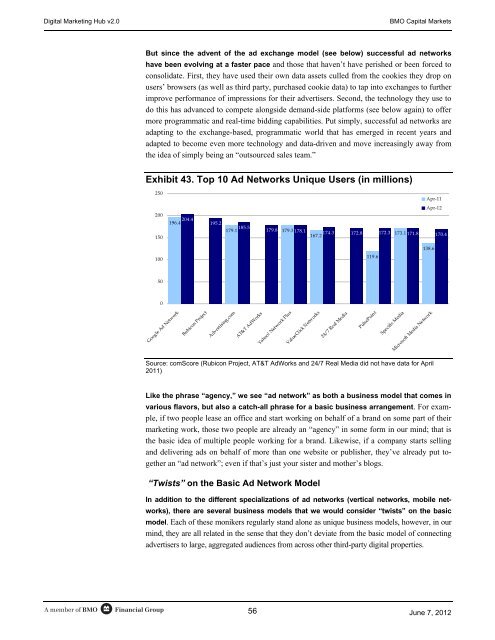DIGITAL MARKETING HUB v2.0 - AdExchanger
DIGITAL MARKETING HUB v2.0 - AdExchanger
DIGITAL MARKETING HUB v2.0 - AdExchanger
You also want an ePaper? Increase the reach of your titles
YUMPU automatically turns print PDFs into web optimized ePapers that Google loves.
Digital Marketing Hub <strong>v2.0</strong><br />
BMO Capital Markets<br />
But since the advent of the ad exchange model (see below) successful ad networks<br />
have been evolving at a faster pace and those that haven’t have perished or been forced to<br />
consolidate. First, they have used their own data assets culled from the cookies they drop on<br />
users’ browsers (as well as third party, purchased cookie data) to tap into exchanges to further<br />
improve performance of impressions for their advertisers. Second, the technology they use to<br />
do this has advanced to compete alongside demand-side platforms (see below again) to offer<br />
more programmatic and real-time bidding capabilities. Put simply, successful ad networks are<br />
adapting to the exchange-based, programmatic world that has emerged in recent years and<br />
adapted to become even more technology and data-driven and move increasingly away from<br />
the idea of simply being an “outsourced sales team.”<br />
Exhibit 43. Top 10 Ad Networks Unique Users (in millions)<br />
250<br />
Apr-11<br />
Apr-12<br />
200<br />
150<br />
204.4<br />
196.4<br />
195.2<br />
185.5<br />
179.1 179.8 179.3 178.1 174.3 172.8 172.3 173.1<br />
167.2<br />
171.8 170.4<br />
138.6<br />
100<br />
119.6<br />
50<br />
0<br />
Google Ad Network<br />
Rubicon Project<br />
Advertising.com<br />
AT&T AdWorks<br />
Yahoo! Network Plus<br />
ValueClick Networks<br />
24/7 Real Media<br />
PulsePoint<br />
Specific Media<br />
Microsoft Media Network<br />
Source: comScore (Rubicon Project, AT&T AdWorks and 24/7 Real Media did not have data for April<br />
2011)<br />
Like the phrase “agency,” we see “ad network” as both a business model that comes in<br />
various flavors, but also a catch-all phrase for a basic business arrangement. For example,<br />
if two people lease an office and start working on behalf of a brand on some part of their<br />
marketing work, those two people are already an “agency” in some form in our mind; that is<br />
the basic idea of multiple people working for a brand. Likewise, if a company starts selling<br />
and delivering ads on behalf of more than one website or publisher, they’ve already put together<br />
an “ad network”; even if that’s just your sister and mother’s blogs.<br />
“Twists” on the Basic Ad Network Model<br />
In addition to the different specializations of ad networks (vertical networks, mobile networks),<br />
there are several business models that we would consider “twists” on the basic<br />
model. Each of these monikers regularly stand alone as unique business models, however, in our<br />
mind, they are all related in the sense that they don’t deviate from the basic model of connecting<br />
advertisers to large, aggregated audiences from across other third-party digital properties.<br />
A member of BMO<br />
Financial Group<br />
56<br />
June 7, 2012


